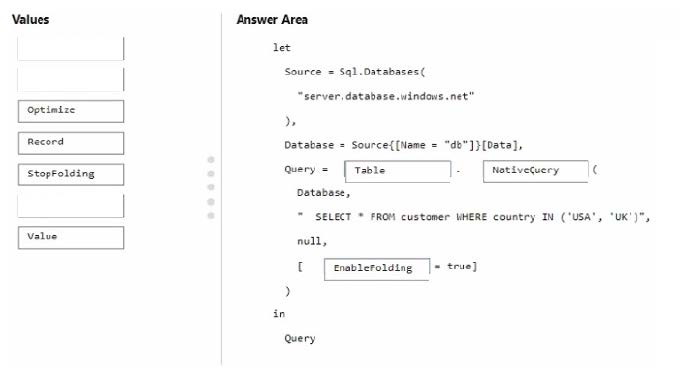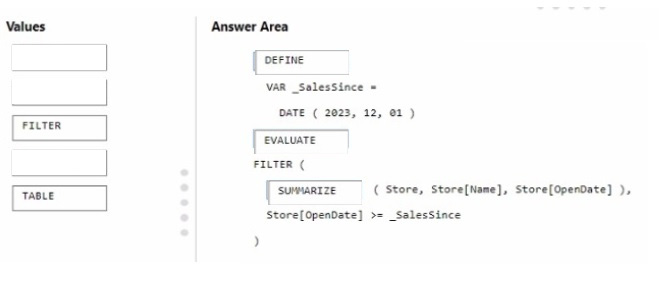DP-600 Online Practice Questions and Answers
You have a Fabric workspace that contains a DirectQuery semantic model. The model queries a data source that has 500 million rows.
You have a Microsoft Power Bl report named Report1 that uses the model. Report! contains visuals on multiple pages.
You need to reduce the query execution time for the visuals on all the pages.
What are two features that you can use? Each correct answer presents a complete solution.
NOTE: Each correct answer is worth one point.
A. user-defined aggregations
B. automatic aggregation
C. query caching
D. OneLake integration
You have a Fabric tenant that contains a semantic model. The model uses Direct Lake mode.
You suspect that some DAX queries load unnecessary columns into memory.
You need to identify the frequently used columns that are loaded into memory.
What are two ways to achieve the goal? Each correct answer presents a complete solution.
NOTE: Each correct answer is worth one point.
A. Use the Analyze in Excel feature.
B. Use the Vertipaq Analyzer tool.
C. Query the $system.discovered_STORAGE_TABLE_COLUMN-iN_SEGMeNTS dynamic management view (DMV).
D. Query the discover_hehory6Rant dynamic management view (DMV).
You have a Fabric tenant that contains a warehouse. The warehouse uses row-level security (RLS). You create a Direct Lake semantic model that uses the Delta tables and RLS of the warehouse. When users interact with a report built from the model, which mode will be used by the DAX queries?
A. DirectQuery
B. Dual
C. Direct Lake
D. Import
You have a Fabric tenant tha1 contains a takehouse named Lakehouse1. Lakehouse1 contains a Delta table named Customer.
When you query Customer, you discover that the query is slow to execute. You suspect that maintenance was NOT performed on the table.
You need to identify whether maintenance tasks were performed on Customer.
Solution: You run the following Spark SQL statement:
EXPLAIN TABLE customer
Does this meet the goal?
A. Yes
B. No
You have a Fabric warehouse that contains a table named Staging.Sales. Staging.Sales contains the following columns.

You need to write a T-SQL query that will return data for the year 2023 that displays ProductID and ProductName arxl has a summarized Amount that is higher than 10,000. Which query should you use?
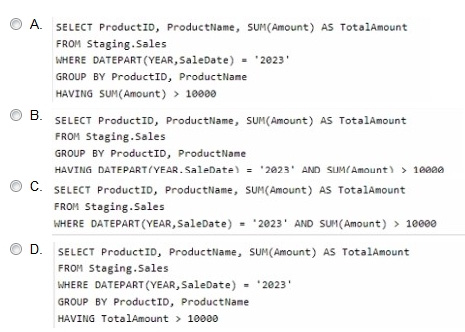
A. Option A
B. Option B
C. Option C
D. Option D
You have a Fabric tenant that contains 30 CSV files in OneLake. The files are updated daily.
You create a Microsoft Power Bl semantic model named Modell that uses the CSV files as a data source. You configure incremental refresh for Model 1 and publish the model to a Premium capacity in the Fabric tenant.
When you initiate a refresh of Model1, the refresh fails after running out of resources.
What is a possible cause of the failure?
A. Query folding is occurring.
B. Only refresh complete days is selected.
C. XMLA Endpoint is set to Read Only.
D. Query folding is NOT occurring.
E. The data type of the column used to partition the data has changed.
You have source data in a folder on a local computer.
You need to create a solution that will use Fabric to populate a data store. The solution must meet the following requirements:
Support the use of dataflows to load and append data to the data store.
Ensure that Delta tables are V-Order optimized and compacted automatically.
Which type of data store should you use?
A. a lakehouse
B. an Azure SQL database
C. a warehouse
D. a KQL database
You are creating a semantic model in Microsoft Power Bl Desktop.
You plan to make bulk changes to the model by using the Tabular Model Definition Language (TMDL) extension for Microsoft Visual Studio Code.
You need to save the semantic model to a file.
Which file format should you use?
A. PBIP
B. PBIX
C. PBIT
D. PBIDS
You have a Fabric tenant that contains a semantic model named Model1. Model1 uses Import mode. Model1 contains a table named Orders. Orders has 100 million rows and the following fields.
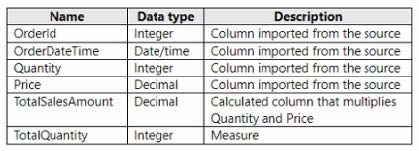
You need to reduce the memory used by Model! and the time it takes to refresh the model. Which two actions should you perform? Each correct answer presents part of the solution. NOTE: Each correct answer is worth one point.
A. Split OrderDateTime into separate date and time columns.
B. Replace TotalQuantity with a calculated column.
C. Convert Quantity into the Text data type.
D. Replace TotalSalesAmount with a measure.
What should you recommend using to ingest the customer data into the data store in the AnatyticsPOC workspace?
A. a stored procedure
B. a pipeline that contains a KQL activity
C. a Spark notebook
D. a dataflow
You have a Fabric tenant that contains a warehouse named Warehouse1. Warehouse1 contains a fact table named FactSales that has one billion rows. You run the following TSQL statement.
CREATE TABLE test.FactSales AS CLONE OF Dbo.FactSales;
For each of the following statements, select Yes if the statement is true. Otherwise, select No. NOTE: Each correct selection is worth one point.
Hot Area:

For each of the following statements, select Yes if the statement is true. Otherwise, select No. NOTE: Each correct selection is worth one point.
Hot Area:

You are creating a dataflow in Fabric to ingest data from an Azure SQL database by using a T-SQL statement.
You need to ensure that any foldable Power Query transformation steps are processed by the Microsoft SQL Server engine.
How should you complete the code? To answer, drag the appropriate values to the correct targets. Each value may be used once, more than once, or not at all. You may need to drag the split bar between panes or scroll to view content. NOTE: Each correct selection is worth one point.
Select and Place:
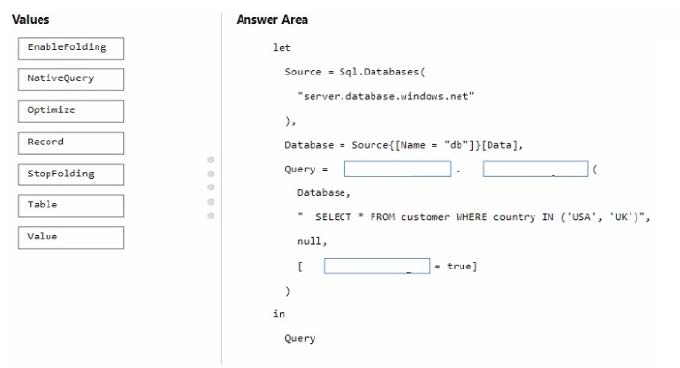
You have a Fabric tenant that contains a semantic model. The model contains data about retail stores.
You need to write a DAX query that will be executed by using the XMLA endpoint The query must return a table of stores that have opened since December 1,2023.
How should you complete the DAX expression? To answer, drag the appropriate values to the correct targets. Each value may be used once, more than once, or not at all. You may need to drag the split bar between panes or scroll to view
content.
NOTE: Each correct selection is worth one point.
Select and Place:
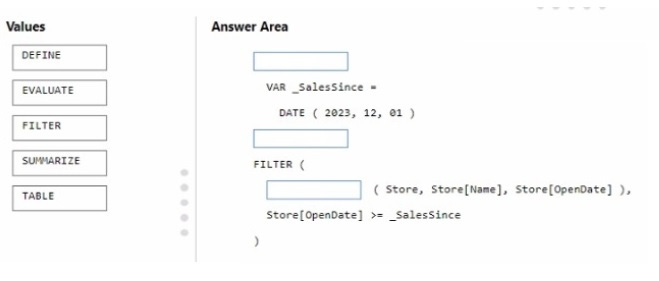
You have a Fabric tenant that contains a lakehouse named Lakehouse1
Readings from 100 loT devices are appended to a Delta table in Lakehouse1. Each set of readings is approximately 25 KB. Approximately 10 GB of data is received daily.
All the table and SparkSession settings are set to the default.
You discover that queries are slow to execute. In addition, the lakehouse storage contains data and log files that are no longer used.
You need to remove the files that are no longer used and combine small files into larger files with a target size of 1 GB per file.
What should you do? To answer, drag the appropriate actions to the correct requirements.
Each action may be used once, more than once, or not at all. You may need to drag the split bar between panes or scroll to view content.
NOTE: Each correct selection is worth one point.
Select and Place:




